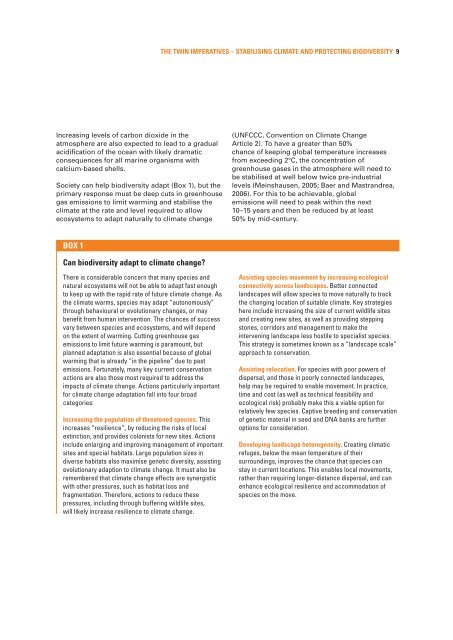Meeting Europe's renewable energy targets in harmony with - RSPB
Meeting Europe's renewable energy targets in harmony with - RSPB
Meeting Europe's renewable energy targets in harmony with - RSPB
Create successful ePaper yourself
Turn your PDF publications into a flip-book with our unique Google optimized e-Paper software.
THE TWIN IMPERATIVES – STABILISING CLIMATE AND PROTECTING BIODIVERSITY 9<br />
Increas<strong>in</strong>g levels of carbon dioxide <strong>in</strong> the<br />
atmosphere are also expected to lead to a gradual<br />
acidification of the ocean <strong>with</strong> likely dramatic<br />
consequences for all mar<strong>in</strong>e organisms <strong>with</strong><br />
calcium-based shells.<br />
Society can help biodiversity adapt (Box 1), but the<br />
primary response must be deep cuts <strong>in</strong> greenhouse<br />
gas emissions to limit warm<strong>in</strong>g and stabilise the<br />
climate at the rate and level required to allow<br />
ecosystems to adapt naturally to climate change<br />
(UNFCCC, Convention on Climate Change<br />
Article 2). To have a greater than 50%<br />
chance of keep<strong>in</strong>g global temperature <strong>in</strong>creases<br />
from exceed<strong>in</strong>g 2°C, the concentration of<br />
greenhouse gases <strong>in</strong> the atmosphere will need to<br />
be stabilised at well below twice pre-<strong>in</strong>dustrial<br />
levels (Me<strong>in</strong>shausen, 2005; Baer and Mastrandrea,<br />
2006). For this to be achievable, global<br />
emissions will need to peak <strong>with</strong><strong>in</strong> the next<br />
10–15 years and then be reduced by at least<br />
50% by mid-century.<br />
BOX 1<br />
Can biodiversity adapt to climate change?<br />
There is considerable concern that many species and<br />
natural ecosystems will not be able to adapt fast enough<br />
to keep up <strong>with</strong> the rapid rate of future climate change. As<br />
the climate warms, species may adapt “autonomously”<br />
through behavioural or evolutionary changes, or may<br />
benefit from human <strong>in</strong>tervention. The chances of success<br />
vary between species and ecosystems, and will depend<br />
on the extent of warm<strong>in</strong>g. Cutt<strong>in</strong>g greenhouse gas<br />
emissions to limit future warm<strong>in</strong>g is paramount, but<br />
planned adaptation is also essential because of global<br />
warm<strong>in</strong>g that is already “<strong>in</strong> the pipel<strong>in</strong>e” due to past<br />
emissions. Fortunately, many key current conservation<br />
actions are also those most required to address the<br />
impacts of climate change. Actions particularly important<br />
for climate change adaptation fall <strong>in</strong>to four broad<br />
categories:<br />
Increas<strong>in</strong>g the population of threatened species. This<br />
<strong>in</strong>creases “resilience”, by reduc<strong>in</strong>g the risks of local<br />
ext<strong>in</strong>ction, and provides colonists for new sites. Actions<br />
<strong>in</strong>clude enlarg<strong>in</strong>g and improv<strong>in</strong>g management of important<br />
sites and special habitats. Large population sizes <strong>in</strong><br />
diverse habitats also maximise genetic diversity, assist<strong>in</strong>g<br />
evolutionary adaption to climate change. It must also be<br />
remembered that climate change effects are synergistic<br />
<strong>with</strong> other pressures, such as habitat loss and<br />
fragmentation. Therefore, actions to reduce these<br />
pressures, <strong>in</strong>clud<strong>in</strong>g through buffer<strong>in</strong>g wildlife sites,<br />
will likely <strong>in</strong>crease resilience to climate change.<br />
Assist<strong>in</strong>g species movement by <strong>in</strong>creas<strong>in</strong>g ecological<br />
connectivity across landscapes. Better connected<br />
landscapes will allow species to move naturally to track<br />
the chang<strong>in</strong>g location of suitable climate. Key strategies<br />
here <strong>in</strong>clude <strong>in</strong>creas<strong>in</strong>g the size of current wildlife sites<br />
and creat<strong>in</strong>g new sites, as well as provid<strong>in</strong>g stepp<strong>in</strong>g<br />
stones, corridors and management to make the<br />
<strong>in</strong>terven<strong>in</strong>g landscape less hostile to specialist species.<br />
This strategy is sometimes known as a “landscape scale”<br />
approach to conservation.<br />
Assist<strong>in</strong>g relocation. For species <strong>with</strong> poor powers of<br />
dispersal, and those <strong>in</strong> poorly connected landscapes,<br />
help may be required to enable movement. In practice,<br />
time and cost (as well as technical feasibility and<br />
ecological risk) probably make this a viable option for<br />
relatively few species. Captive breed<strong>in</strong>g and conservation<br />
of genetic material <strong>in</strong> seed and DNA banks are further<br />
options for consideration.<br />
Develop<strong>in</strong>g landscape heterogeneity. Creat<strong>in</strong>g climatic<br />
refuges, below the mean temperature of their<br />
surround<strong>in</strong>gs, improves the chance that species can<br />
stay <strong>in</strong> current locations. This enables local movements,<br />
rather than requir<strong>in</strong>g longer-distance dispersal, and can<br />
enhance ecological resilience and accommodation of<br />
species on the move.
















